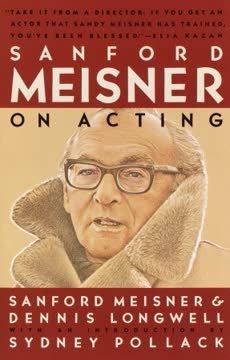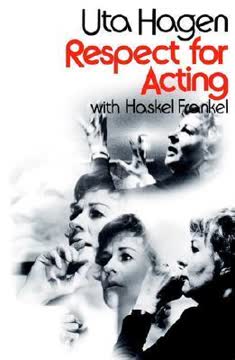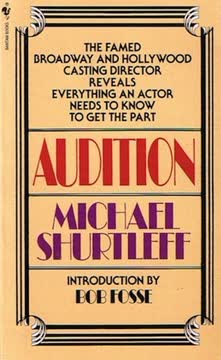Key Takeaways
1. The Foundation: The Reality of Doing
The foundation of acting is the reality of doing.
Real actions matter. Acting begins not with pretending, but with genuinely doing something. Whether it's walking up steps, counting light bulbs, or listening to sounds, the actor must fully engage in the physical task as themselves, not as a character. This commitment to the reality of the action grounds the actor in the present moment.
Focus outward. By concentrating on a concrete, tangible task outside of oneself, the actor takes the focus off their own self-consciousness. This external focus is crucial for freeing the actor from the trap of "thinking" or "showing" emotion, allowing truthful behavior to emerge naturally from the engagement with the task.
- Counting light bulbs
- Listening for cars
- Examining a partner's appearance
- Singing a melody to oneself
Authenticity is key. The doing must be authentic and specific, just as in real life. There is no theatricality in the initial stage; the actor simply performs the task as they would if no one were watching. This simple, truthful engagement with the physical world is the bedrock upon which all subsequent acting technique is built.
2. Building Connection: The Repetition Exercise
It is the basis of what eventually becomes emotional dialogue.
Mindless repetition builds connection. The core exercise involves two actors facing each other, repeating an observation about the other person back and forth. Initially mechanical and seemingly "inhuman," this repetitive exchange forces actors to truly listen and respond to their partner, establishing a fundamental connection.
- "Your hair is shiny." / "Your hair is shiny."
- "Your earring is small." / "Your earring is small."
Shifting to personal point of view. The exercise evolves when one actor's instinct prompts a change in the repetition, reflecting their personal reaction to the partner's behavior. This shift introduces human quality and spontaneity, moving beyond mere mechanics to genuine interaction.
- "Your hair is shiny." / "Your hair is shiny." / "You're getting annoyed." / "I'm getting annoyed."
Instinct drives change. The dialogue changes are dictated by the actor's immediate, instinctive response to their partner, not by pre-planned ideas or logical progression. This trains the actor to rely on impulse and the dynamic exchange with the other person, forming the basis for truthful, moment-to-moment acting.
3. Adding Purpose: The Independent Activity
The independent activity must be difficult, truly difficult, and the reason why you do it has to have a consuming reality for you.
Task with stakes. To deepen concentration and generate emotion, the actor is given a difficult, independent activity to perform while simultaneously engaging in the repetition exercise with a partner. The activity must have a compelling, personal reason behind it, making it feel urgent and consuming.
- Searching a phone book for a lost love's address
- Gluing together a broken, sentimental plate
- Practicing a difficult piece of music on an instrument
- Writing an important letter
Difficulty fuels concentration. The inherent difficulty of the task demands the actor's full attention, preventing them from focusing on their partner or self-consciously "acting." This intense concentration on the independent activity creates a state of "public solitude," where the actor is fully engaged in their private world despite being observed.
Reason provides justification. The personal, high-stakes reason for doing the activity provides the emotional fuel. This internal drive, combined with the external focus on the task, creates a rich inner life that can be genuinely affected by the partner's presence and actions, leading to spontaneous, truthful responses.
4. Igniting Emotion: The Power of Preparation
Preparation is to acting what warming up the motor is to driving a car on a cold day.
Starting emotionally alive. Preparation is the process by which an actor brings themselves to a state of emotional aliveness before a scene begins. The goal is to enter the scene already filled with the necessary feeling, rather than trying to generate it on stage. This ensures the actor is emotionally available from the first moment.
Imagination as the source. Unlike "emotion memory" (recalling past real-life feelings), Meisner emphasizes using imagination and "wishful thinking" as the primary source for preparation. Fantasies, whether ambitious or erotic (as per Freud), can be powerful catalysts for generating emotion, often more potent and reliable than actual memories.
- Imagining winning the lottery
- Fantasizing about a triumphant success
- Inventing a deeply humiliating experience
Personal and private. The specific content of the preparation is deeply personal and need not be related to the play's circumstances, only to the desired emotional state. It is a private process, like Macready shaking a ladder backstage to induce rage, the source of which is irrelevant to the audience, only the resulting emotional truth matters.
5. Clarifying the Text: The Magic As If (Particularization)
It’s your personal example chosen from your experience or your imagination which emotionally clarifies the cold material of the text.
Connecting personal truth to text. When a script presents circumstances or emotions alien to the actor's personal experience, a "particularization" or "as if" is used. This involves finding a personal, imaginative equivalent that evokes the required emotional response, making the text's meaning emotionally accessible.
- Playing a character accused of being a lesbian as if you were accused of something personally horrifying (e.g., witchcraft, murder).
- Playing a character burning a manuscript as if you were burning a person you hate.
Emotional clarity for the actor. The "as if" is a tool for the actor to understand and embody the emotional core of a moment or line, not a literal substitution of the play's circumstances. It clarifies the feeling required, allowing the actor to play the text truthfully from that emotional place.
Instinctive choice. Choosing the right "as if" comes from the actor's instinct and imagination in response to the text. It is worked on in rehearsal and, once effective, becomes a consistent, internal trigger for that specific moment or beat in the scene, providing the emotional backbone for the written words.
6. Living Moment to Moment: Working Off Your Partner
Acting is not talking. It is living off the other fellow.
Response is key. True acting is a continuous process of responding truthfully to what your partner is doing and saying in the present moment. It is not about delivering pre-planned lines or emotions, but about a dynamic, spontaneous exchange of impulses.
- Reacting to a partner's silence
- Responding to a change in their tone or behavior
- Picking up on their emotional state
Impulse over cue. Actors should listen for and react to their partner's emotional impulses, not just their verbal cues. The impulse for a response often comes early, even before the partner finishes speaking, leading to a more organic and lifelike flow of dialogue and action.
- Hearing "scotch" in a list of drinks and reacting immediately.
Authentic interaction. This moment-to-moment responsiveness, fueled by preparation and grounded in the reality of doing, creates authentic human interaction on stage. It ensures that the scene is alive, unpredictable, and rooted in the genuine connection between the actors, rather than being a pre-determined performance.
7. Character Emerges from Behavior
Character comes from how you do what you do.
Internal drives shape external actions. Character is not something an actor "puts on" or intellectualizes; it is revealed through how a person behaves and how they feel about what they are doing. The internal emotional life and instinctive responses dictate the external manifestation of the character.
- An impulsive person buys a suit they can't afford.
- A cautious person hesitates before agreeing.
- A character's bitterness manifests in their tone and actions.
Emotional essence is core. The fundamental aspect of character is its emotional essence – the underlying feelings, attitudes, and drives that shape behavior. External attributes like accents or costumes are secondary and should be built upon this internal truth.
Truthful doing reveals character. By focusing on truthfully doing the actions and responding honestly to the circumstances and their partner, the actor allows the character's nature to emerge organically. The "how" of the doing, informed by the actor's emotional life and imagination, defines the character.
8. Trusting Instinct Over Intellect
Thinking has no part in this process.
Instinct is the actor's guide. Meisner strongly advocates for actors to bypass intellectual analysis and logical planning in favor of trusting their instincts and impulses. The most truthful and spontaneous acting arises when the actor reacts from their gut, not their head.
- Reacting impulsively to a partner's action.
- Letting instinct dictate changes in repetition.
- Choosing preparations and particularizations that feel right.
Logic hinders spontaneity. Overthinking, trying to be logical, or planning responses stifles spontaneity and leads to artificial, "stock-company" acting. The actor's job is to fill the playwright's words with life, and that life comes from the impulsive, emotional self.
Training the impulsive self. The exercises, particularly the repetition game, are designed to train the actor to rely on what they receive from their partner and their own immediate, often illogical, responses. This process helps break the habit of intellectual control and opens the door to genuine emotional expression.
9. Don't Act, Don't Fake, Don't Pretend - Work
Don’t act, don’t fake, don’t pretend—work!
Focus on the process, not the result. The emphasis is always on the honest execution of the technique and exercises ("work"), rather than trying to "perform" or "show" emotion. Faking or indicating emotion is immediately detectable and undermines the truthfulness of the acting.
Truthful behavior is the goal. The aim is to create real, truthful behavior within the imaginary circumstances. This means fully committing to the tasks, responding genuinely to the partner, and allowing emotions to arise organically from the situation and preparation, rather than forcing them.
Technique supports truth. The various exercises and principles (repetition, independent activity, preparation, particularization) are tools to help the actor access and express their emotional truth spontaneously. They are means to an end – living truthfully on stage – not ends in themselves.
10. The Actor's Instrument: Self-Knowledge and Vulnerability
The truth of ourselves is the root of our acting.
Personal truth is the source. The actor's primary instrument is themselves. Understanding and being willing to reveal one's own emotional life, vulnerabilities, and instincts is fundamental to the craft. Acting requires a degree of self-knowledge and the courage to be exposed.
Emotions cannot be hidden. While emotions can be masked or controlled, they cannot be truly hidden. An actor's inner state will inevitably color their behavior. Learning to work with one's own emotional landscape, including nervousness or insecurity, is part of the process.
Talent and temperament. Natural talent involves a powerful imagination and emotional responsiveness. Temperament influences the types of roles an actor is naturally suited for. Recognizing one's own strengths and limitations, and using personal experiences (even difficult ones) as fuel, is key to "making the part your own."
11. The Lifelong Journey: It Takes Time
It takes twenty years to become an actor.
Mastery requires dedication. Becoming a skilled actor is a long and demanding process, requiring years of consistent work, practice, and dedication. Like mastering a musical instrument or any other art form, it involves gradually integrating technique until it becomes instinctive.
Progress is gradual. Learning to act involves small, incremental steps and often feels slow or frustrating. Breakthroughs happen over time as the actor consistently applies the principles and works through their personal blocks and habits. Patience is essential for both the student and the teacher.
Continuous learning. The journey of an actor is one of continuous learning and refinement. Even experienced actors benefit from returning to the fundamentals and continuing to explore their instrument and the craft. The goal is not just to book jobs, but to deepen one's capacity for truthful expression.
Last updated:
FAQ
What’s Sanford Meisner on Acting by Sanford Meisner about?
- Comprehensive acting guide: The book details Sanford Meisner’s unique approach to acting, emphasizing truthful behavior within imaginary circumstances.
- Teaching methods and philosophy: It presents Meisner’s classroom exercises, scene work, and reflections, offering both practical and theoretical insights.
- Historical and personal context: Readers gain biographical background on Meisner, his influences, and his role in shaping American acting.
- Focus on emotional truth: The text stresses the importance of emotional reality and instinct over intellectual performance.
Why should I read Sanford Meisner on Acting by Sanford Meisner?
- Learn from a master teacher: Meisner is a foundational figure in American acting, and the book provides direct access to his methods and philosophy.
- Practical and applicable exercises: The book offers concrete tools and exercises that actors can use immediately to improve their craft.
- Addresses common acting challenges: Meisner’s advice helps actors overcome self-consciousness, emotional blockages, and artificiality.
- Valuable for all levels: Whether you’re a beginner or experienced actor, the book’s insights are relevant and transformative.
What are the key takeaways from Sanford Meisner on Acting by Sanford Meisner?
- Truthful acting is central: Acting is defined as “living truthfully under imaginary circumstances,” prioritizing authenticity over pretense.
- Instinct and impulse matter: Meisner’s method trains actors to respond instinctively and emotionally, not intellectually.
- Preparation is essential: Emotional preparation and imaginative engagement are crucial for entering scenes with aliveness.
- Practical exercises drive learning: Techniques like the Word Repetition Game and particularization are foundational to the method.
What are the core principles of the Sanford Meisner acting technique as explained in Sanford Meisner on Acting?
- Reality of doing: The foundation of acting is genuinely doing actions and listening truthfully, not pretending or overthinking.
- Word Repetition Game: This exercise builds truthful connection and instinctive responses between actors.
- Emotional preparation: Actors use imagination or personal experience to create a truthful emotional state before a scene.
- Focus on impulses: The technique emphasizes responding to emotional impulses rather than external cues.
How does Sanford Meisner define “acting” and what is his view on emotional memory in Sanford Meisner on Acting?
- Acting as truthful behavior: Meisner defines acting as “living truthfully under imaginary circumstances,” focusing on spontaneous, honest responses.
- Rejection of affective memory: He discourages relying on personal emotional recall, favoring imagination and present-moment reality.
- Given circumstances are key: Emotional truth comes from engaging with the play’s circumstances, not dredging up past experiences.
- Organic emotional response: This approach fosters immediate, authentic reactions rather than forced or artificial emotions.
What is the “Word Repetition Game” in the Sanford Meisner method, and why is it important?
- Basic exercise for connection: Two actors repeat simple observations to each other, building focus on listening and truthful response.
- Foundation for emotional impulses: The exercise evolves from mechanical repetition to emotionally charged, instinctive dialogue.
- Teaches instinct over intellect: It helps actors move concentration outside themselves, reducing self-consciousness and overthinking.
- Essential for truthful acting: The game is a cornerstone of Meisner’s method, training actors to react authentically.
How does Sanford Meisner approach “preparation” in acting, according to Sanford Meisner on Acting?
- Preparation as emotional aliveness: Actors use preparation to enter scenes emotionally alive, not empty or mechanical.
- Imagination and personal stimuli: Meisner encourages finding personal, imaginative ways to stimulate genuine emotion before a scene.
- Brief and private process: Preparation is only for the first moment of a scene and should not be “shown” or overdone.
- Foundation for spontaneity: Once the scene begins, actors must respond spontaneously to their partner and the situation.
What role do instinct and impulse play in the Sanford Meisner acting technique?
- Instinct as talent’s source: Meisner believes true talent comes from following natural instincts rather than learned or intellectual responses.
- Impulse-driven dialogue: Actors are trained to pick up on their partner’s behavior and respond organically, creating lively exchanges.
- Overcoming social conditioning: The method encourages actors to embrace honest, even impolite, reactions for authentic performance.
- Moment-to-moment interaction: Acting becomes a dynamic, present-tense process rooted in genuine impulses.
How does Sanford Meisner differentiate between “cues” and “impulses” in acting?
- Cues are external triggers: Cues are the words or actions that signal when to speak or move, often leading to mechanical acting.
- Impulses are emotional responses: Impulses arise from genuine emotional reactions to the partner or situation, leading to truthful acting.
- Focus on impulses for truth: Meisner instructs actors to respond to impulses, not just cues, for more natural and connected performances.
- Creates dynamic performances: This distinction helps actors avoid robotic delivery and fosters authentic interaction.
How does Sanford Meisner address emotional blockages and self-consciousness in actors in Sanford Meisner on Acting?
- Recognizing common challenges: Meisner identifies self-consciousness and the desire to “perform” as major obstacles to truthful acting.
- Openness to suggestion: He encourages actors to be receptive to their partner and the moment, reducing internal pressure.
- Preparation as a tool: Emotional preparation helps actors access genuine feelings without forcing them.
- Allowing imperfection: Meisner advises actors to let go of intellectual control and embrace spontaneity, even if it feels “stupid.”
What is “particularization” or “the magic as if” in the Sanford Meisner method, and how is it used?
- Personal imaginative connection: Particularization involves finding a personal example that clarifies the emotional truth of a scene.
- Bridging alien circumstances: It helps actors emotionally access situations that are unfamiliar or difficult.
- Avoids intellectualizing: The technique ensures that emotional truth comes from personal connection, not just understanding the text.
- Makes text meaningful: Particularization brings the script to life by rooting it in the actor’s own feelings and imagination.
What are the best quotes from Sanford Meisner on Acting by Sanford Meisner, and what do they mean?
- “The foundation of acting is the reality of doing.” This highlights the importance of genuine action and truthful behavior in performance.
- “Don’t do something until something happens to make you do it.” Meisner emphasizes waiting for real impulses rather than forcing actions.
- “Acting is living truthfully under imaginary circumstances.” This is the core definition of Meisner’s technique, focusing on authenticity.
- “You cannot be a gentleman and be an actor.” Meisner challenges actors to abandon social inhibitions for honest, instinctive reactions.
- “There’s no such thing as nothing.” Every moment on stage, even silence, is filled with emotional content and meaning.
Review Summary
Sanford Meisner on Acting receives mixed reviews. Many praise Meisner's insights into acting technique, emphasizing authenticity, imagination, and emotional truth. Readers appreciate the book's unique format, presenting Meisner's teaching through classroom transcripts. Some find it enlightening and applicable beyond acting, while others criticize Meisner's approach as potentially harmful or outdated. Critics note the book's repetitive nature and lack of practical exercises. Overall, it's considered a valuable resource for actors, though more beneficial when paired with practical experience in Meisner's technique.
Similar Books
Download PDF
Download EPUB
.epub digital book format is ideal for reading ebooks on phones, tablets, and e-readers.










